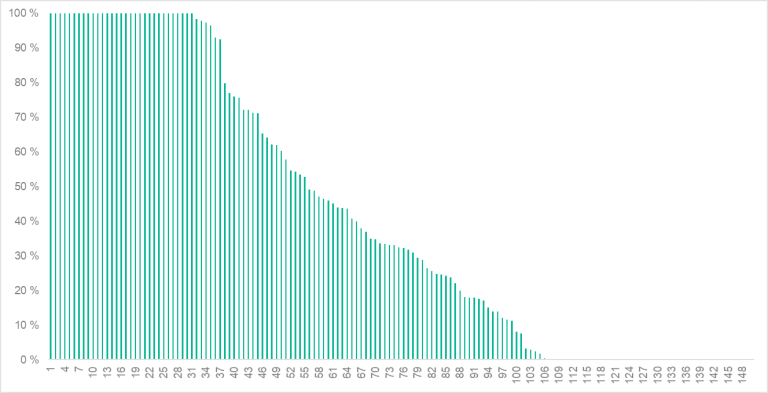
The road to Paris – KLP’s roadmap to net zero
KLP supports the Paris Agreement and the 1,5-degree target. Now, the board has adopted KLP’s roadmap to net zero emissions by 2050. The roadmap describes how KLP will work towards and measure our contribution to the goals in the Paris Agreement.
e Paris Agreement was adopted in 2015 and aims to limit global warming to 1.5 degrees. KLP is not the only financial institution to have pledged alignment with the Paris Agreement. The challenge is that there is no single, incontrovertible method for translating the 1.5-degree goal into practice. Therefore, we have developed a framework based on internationally recognised standards and best practices: KLP's own roadmap to Paris.
The roadmap shows how KLP will assess each individual investment against an emission pathway that is compatible with the 1.5-degree target. This means that KLP will set a specific short-term climate target for the portfolio, as well as apply best practice when it comes to assessment methods and the use of climate data.
KLP's goal of aligning our investment portfolio with the 1.5-degree goal consists of several sub-goals:
- Increase climate-friendly investments by NOK 6 billion every year.
- Set strategies and goals so that high-emission sectors have emissions in line with the Paris Agreement by 2025.
- Ensure that emissions are reduced by 7 per cent every year from 2019 to 2030, and assess the climate goals of companies we are invested in against the emission pathway.
- Have net zero emissions from the investment portfolio by 2050.
Transparency about our roadmap
Transparency about companies' net zero targets is essential as the business and finance community must learn from each other. Furthermore, our stakeholders must understand how KLP actually works towards the 1.5-degree target. Therefore, we have published our entire roadmap to net zero emissions and will periodically report on our results.
The table below shows some of the results for KLP's portfolio as of 2021 and 2020. The table will be updated as we make new measurements. More information about this year’s results can be found in KLP’s sustainability accounts for 2021.
Companies must meet strict requirements if they are to operate in line with the goals of the Paris Agreement. This is also clear from KLP’s Paris Alignment Percentage (PAP). Expanding the measurement horizon from one to two years means that carbon intensity must be reduced by more than seven per cent per annum over two years, instead of over one year. The market has also developed, changing the weighting such that sectors with a high PAP have become a smaller percentage of the portfolio, while sectors with a low PAP have gained ground. The reduction in KLP’s PAP is therefore attributable to companies not doing enough in relation to the goals of the Paris Agreement and to changes in the market.
The graph below shows the Paris Alignment Percentage for the various sectors in the category “Other investments”. Out of 150 sectors in 2021, 30 sectors are 100 per cent Paris aligned, while 44 sectors are 0 per cent Paris aligned. In comparison, 26 of 141 sectors in 2020 were 100 per cent Paris aligned and 58 were 0 per cent Paris aligned.

Greenhouse gas emissions from KLP’s investments
To raise awareness of the climate impact of investments and highlight developments over time, KLP measures and reports the climate profile of the investments. The table below shows the climate profile of our investments as of 31.12.2020:
KLP reports according to the recommendations from TCFD and reports on the four recommended indicators for carbon measurement of investments. The definition of the indicators varies across different sources, and even varies within the EU regulations. For 2020, KLP has chosen to adopt best practice from the various regulations, and has therefore made extensive changes to the method we use to calculate the climate profile of our investments:
- The climate indicators include both listed shares and corporate bonds, where KLP previously only included shares.
- To calculate carbon intensity, carbon footprint and carbon emissions, we use “enterprise value", which includes a company’s stock value and debt. In previous years, we used the market value of a company, which includes only shares. KLP does not have access to historical data on enterprise value, so it has not been possible to calculate the indicators for previous years with the new method.
- The climate indicators are calculated for scope 1 and 2 and for scope 1, 2 and 3.
- Following TCFD’s definition, the calculations are made in US dollars.
The changes are significant improvements to KLP's climate accounts. However, because we lack historical data for companies' enterprise value, it is not possible to calculate the indicators for previous years. To be transparent about the development of emissions over time, we have therefore calculated the weighted carbon intensity using the companies’ market value and Norwegian kroner. With this method, we have historical data, and the figures show a reduction in KLP's carbon intensity: